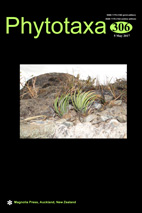Abstract
Three new species of Ulnaria from the Wuling Mountains Area, China, have been studied by light and scanning electron microscopy. All possess at least six closed girdle bands. The pattern of valve striation is not uniform as some do not have a corresponding opposite structure. The cells of Ulnaria sinensis sp. nov. are linked and form colonies with frustules connected by interlocking linking spines. U. sinensis has very long valves (296–512 µm) and uniseriate striae. Both Ulnaria ulnabiseriata sp. nov. and Ulnaria gaowangjiensis sp. nov. have biseriate striae. U. ulnabiseriata differs from U. gaowangjiensis in LM by its more lanceolate valve shape as the valves of U. ulnabiseriata taper towards the pole from one third of the length of the valve, whist U. gaowangjiensis tapers towards the pole from two thirds of the length of the valve, and by its larger valve length (105–229 µm vs 61–108 µm). The three new species are all epilithic and were found in freshwater streams in or near nature reserves.

